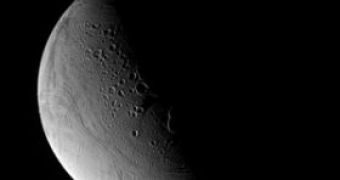Well, there is evidence of water on Enceladus' surface but the real question is still whether there are any life forms present there or not. While doing a survey of Saturn's tiny moon, the Cassini-Huygens probe detected a hot spot on the old moon's surface, which usually has a temperature lower than that of cold ice. The Cassini-Huygens probe has as primary mission the study of the Saturn planet and its moon Titan.
The hot spot observed by Cassini, seems to be placed in the region of the south pole and has a high enough temperature to melt water ice and eject clouds of water vapor well above the surface of the small moon, after which they turn into ice crystals smaller than the wavelength of light, which is about one thousand of a millimeter. William B. McKinnon, professor of earth and planetary science in Arts & Science at Washington University, compares these special features to smoke structures made out of water ice.
Most of the frozen moons present in the outer regions of the solar system are geologically inactive; however a handfull of such bodies, including Enceladus, show clear evidence that they are geologically active. This particular moon presents so-called venting of water vapor activity, which may suggest the presence of volcanoes, and why not, possibly life.
If there is volcanic activity on Enceladus then it would be responsible for the ice sublimation process similar to that presented by comets as they get closer to the Sun or it could be generated by a different mechanism, such as boiling water like geysers on Earth.
Nevertheless, the presence of life of this remote moon seems to be rather slim due to the fact that these ice plumes contain high amounts of sodium, which has never been detected in high quantities in fresh water plumes on Earth. As water is being circulated through the layers of rock and streambeds, they often filter mineral solutions, but analysis of Enceladus' emissions reveal that this does not apply to the small moon and, furthermore, no boiling or venting processes have been confirmed.
Enceladus' strange activity seems to be generated by Saturn's gravitational pull that creates tides on its crust causing friction between its fault lines present in the vicinity of the south pole, activity that generates enough heat to vaporize the ice to create the distinctive plumes.
Scientists hope that in March next year, as the Cassini-Huygens probe will make its next close step to Saturn's small moon, it will be able to take more detailed pictures in the infrared spectrum of the moon's strange features, impact craters and fissures on its surface.
Previous measurements regarding its characteristics have shown that Enceladus is relatively small, having a diameter of about 500 kilometers, and is mostly a rock-rich body with the surface covered with almost pure water ice. Its temperature average is of about 220 degrees Celsius at the poles and the hot spot observed by the Cassini-Huygens probe is at least 100 degrees Celsius warmer than that.
The tidal gravitational waves detected on Enceladus are in close connection with another one of Saturn's moons, Dione, which has a much wider orbit around the planet, meaning that while Dione completes a rotation Enceladus will make two, determining a resonance in the gravitational pull that powers its tidal wave squeezing and pulling off the surface.
The exact same mechanism, has been observed in two of Jupiter's moons, Io and Europa, which seem to have an extremely active geological activity. According to McKinnon, such small energies are just enough to make the ice active and don't necessarily require extremely hot temperatures like those observed on the surface of Io.

 14 DAY TRIAL //
14 DAY TRIAL //